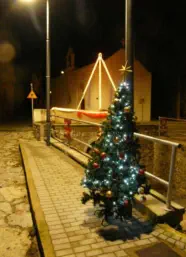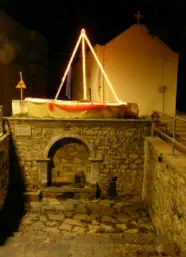Crete is a summer paradise for tourists from around the world, who flock in their thousands to enjoy the brilliant blue skies,
pristine sandy, white beaches, crystal clear seas and the luscious vegetation. However, it is worth a visit during the colder
months out of season, in order to see the snow-capped mountains and smell the olive wood burning from the village
chimneys. Winter days on Crete are quite sunny but windy. It is 15-17 degrees and the Cretans have their own Christmas
tradition – the Santa run where people dress up as Santa and run for charity.
Crete has a lot to offer during the Christmas period and Neapoli is no exception. So here’s a little taste of Christmas.
Christmas celebrations last for 14 days, beginning on Christmas Eve and ending on 6th January (Epiphany). Unlike England
and other European countries, where, particularly in shops, Christmas begins in September, the kick-off here is the beginning
of December. Houses are decorated and the baking begins. Unless you are Georgia from the local supermarket in Neapoli,
Ariadne, who will have had her house decorated since November!
Boats and Trees
Decorated Christmas trees are a Scandinavian and German custom. The tradition was introduced into Greece in 1833 by its
then ruler Prince Otto, who decorated the first tree in his palace. For decades only the upper class took up the tradition and
it wasn’t until after World War II that it became more widely popular. It was much more common for the Greeks to decorate a
small boat. Being a seafaring nation this decorated boat symbolized their respect for the sea and the hope that loved ones
would be home safe for Christmas. Traditional Greeks also hang up a cross covered with a sprig of basil leaves. A shallow
bowl is attached to it with some water to keep the basil fresh and a member from the family sprinkles water from that bowl
all around the house once a day to drive away bad spirits. They also hang pomegranates over the front door of their houses.
The fruit is thrown on the ground and crushed underfoot by someone who, afterwards, enters the house, signifying good luck
and prosperity for the coming year. Greeks believe that goblins or bad spirits appear during the 12 days of Christmas. They
are believed to enter the house through the chimney. So the Yule log is burned throughout the Christmas period.
Christmas Eve & Carol Singers
As early as 7 a.m. on Christmas Eve morning, doorbells start ringing as groups of children wait on the doorstep to be given
permission to sing traditional Christmas carols. They begin with the story of Christ’s birth, good fortune for the house and a
request for a symbolic gift, which is generally a small amount of money and a treat, usually a Christmas honey cake or an
almond snowball.
Christ’s Bread (Christopsomo)
Christ’s bread is a round loaf, which has a cross made of dough in the centre and sprinkled with crushed walnuts or almonds.
It is eaten on Christmas Eve night. It is believed that no knife should be used to cut it; it is therefore torn into pieces by hand.
It is considered very sacred and is made with great care in the hope that the family will have a prosperous year.
Christmas Day
Traditionally, the main dish on Christmas day was pork or lamb, which some families still choose to eat nowadays. The
custom of eating pork was again down to how much money the household had and parts of the pig were preserved and
eaten throughout the rest of the year. When the pig was slaughtered families painted a cross in its blood on children’s
foreheads to protect them from headaches. Turkey made its appearance in the late 19th century, but again it was only to be
found in upper class houses. Nowadays many Greeks opt for turkey instead of pork or lamb. Of course there are cheese and
spinach pies, salads and vegetables on the side. After the meal, as well as the usual sweet filo pastry dishes, there are honey
cakes and almond snowball cakes. Oil, honey, oranges and nuts, Greece’s most famous products, are among the ingredients.








Crete is a summer paradise for tourists from around the
world, who flock in their thousands to enjoy the brilliant blue
skies, pristine sandy, white beaches, crystal clear seas and the
luscious vegetation. However, it is worth a visit during the
colder months out of season, in order to see the snow-
capped mountains and smell the olive wood burning from
the village chimneys. Winter days on Crete are quite sunny
but windy. It is 15-17 degrees and the Cretans have their own
Christmas tradition – the Santa run where people dress up as
Santa and run for charity.
Crete has a lot to offer during the Christmas period and
Neapoli is no exception. So here’s a little taste of Christmas.
Christmas celebrations last for 14 days, beginning on
Christmas Eve and ending on 6th January (Epiphany). Unlike
England and other European countries, where, particularly in
shops, Christmas begins in September, the kick-off here is the
beginning of December. Houses are decorated and the
baking begins. Unless you are Georgia from the local
supermarket in Neapoli, Ariadne, who will have had her
house decorated since November!
Boats and Trees
Decorated Christmas trees are a Scandinavian and German
custom. The tradition was introduced into Greece in 1833 by
its then ruler Prince Otto, who decorated the first tree in his
palace. For decades only the upper class took up the
tradition and it wasn’t until after World War II that it became
more widely popular. It was much more common for the
Greeks to decorate a small boat. Being a seafaring nation
this decorated boat symbolized their respect for the sea and
the hope that loved ones would be home safe for Christmas.
Traditional Greeks also hang up a cross covered with a sprig
of basil leaves. A shallow bowl is attached to it with some
water to keep the basil fresh and a member from the family
sprinkles water from that bowl all around the house once a
day to drive away bad spirits. They also hang pomegranates
over the front door of their houses. The fruit is thrown on
the ground and crushed underfoot by someone who,
afterwards, enters the house, signifying good luck and
prosperity for the coming year. Greeks believe that goblins
or bad spirits appear during the 12 days of Christmas. They
are believed to enter the house through the chimney. So the
Yule log is burned throughout the Christmas period.
Christmas Eve & Carol Singers
As early as 7 a.m. on Christmas Eve morning, doorbells start
ringing as groups of children wait on the doorstep to be given
permission to sing traditional Christmas carols. They begin
with the story of Christ’s birth, good fortune for the house
and a request for a symbolic gift, which is generally a small
amount of money and a treat, usually a Christmas honey cake
or an almond snowball.
Christ’s Bread (Christopsomo)
Christ’s bread is a round loaf, which has a cross made of
dough in the centre and sprinkled with crushed walnuts or
almonds. It is eaten on Christmas Eve night. It is believed
that no knife should be used to cut it; it is therefore torn into
pieces by hand. It is considered very sacred and is made with
great care in the hope that the family will have a prosperous
year.
Christmas Day
Traditionally, the main dish on Christmas day was pork or
lamb, which some families still choose to eat nowadays. The
custom of eating pork was again down to how much money
the household had and parts of the pig were preserved and
eaten throughout the rest of the year. When the pig was
slaughtered families painted a cross in its blood on children’s
foreheads to protect them from headaches. Turkey made its
appearance in the late 19th century, but again it was only to
be found in upper class houses. Nowadays many Greeks opt
for turkey instead of pork or lamb. Of course there are
cheese and spinach pies, salads and vegetables on the side.
After the meal, as well as the usual sweet filo pastry dishes,
there are honey cakes and almond snowball cakes. Oil,
honey, oranges and nuts, Greece’s most famous products, are
among the ingredients. FIND THE RECIPES HERE…
4.webp)

